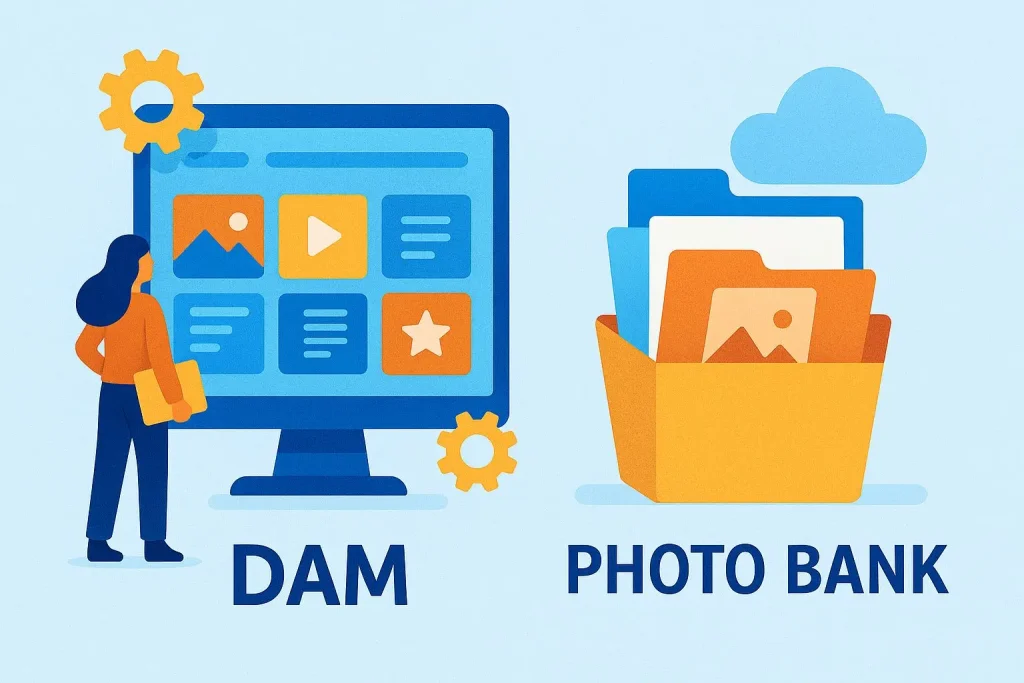Blog
DAM vs. Photobank: Managing Your Visual Content
Every business communication, whether with consumers, investors, or partners, relies on high-quality visual content. As your company grows, you accumulate terabytes of photos, videos, design mockups, packaging source files, and other media. The immediate solution is often a simple corporate photo bank on a company server or cloud service.

However, forward-thinking businesses aiming for sustainable resource management and operational efficiency are choosing a specialized solution: a Digital Asset Management (DAM) system.
This guide will break down the core differences between a basic photo bank and a sophisticated DAM system, using our Intrical DAM platform as an example. It is designed for marketing, PR, brand, and content managers, as well as IT and Data departments tasked with organizing and scaling their company’s media content.
What is a DAM System vs. a Corporate Photobank?
Digital Asset Management (DAM) is a comprehensive system designed to manage a company’s entire digital content library. A DAM allows you to store, organize, find, and distribute various file types — photos, videos, audio, design source files, presentations, certificates, and more. Crucially, a DAM system manages content throughout its entire lifecycle, from creation to archiving, with advanced features like metadata management, version control, and workflow automation.
A Corporate Photobank is typically a simple storage solution, such as a list of folders on a cloud server (e.g., Google Drive, Dropbox, SharePoint). While other file formats are often added, its functionality is significantly limited compared to a DAM system.
Feature Comparison: DAM vs. Corporate Photobank
| Feature | ✅ DAM System (Intrical by Brandquad) | ❌ Corporate Photobank |
|---|---|---|
| Organization & Search | Advanced structuring via rich metadata, custom tags, and collections. Search by any criteria (file type, license, date, etc.). | Limited metadata. Search is typically restricted to keywords in file and folder names. |
| Version Control & Access | Flexible version control with automatic backups and rollback capabilities. Granular, file-level access rights for different user roles. | Limited or no version control, risking data loss. Access controls are basic and folder-level. |
| Business App Integration | Deep integration via API with other core systems like ERP, CMS, and PIM. | Basic integration, mostly limited to office suite applications. |
| File Transformation | Automatically resize, reformat, and create derivative versions of images and videos on the fly using presets. | No native file transformation. Requires separate, third-party software for any edits. |
| License Management | Built-in functionality to track media file licenses, set expiry date notifications, and manage usage rights automatically. | No connection between media and licenses. Requires a separate, manual system to track rights. |
| AI-Powered Tools | AI tools for auto-tagging, file classification, finding similar images, and facial recognition based on your own image database. | AI functionality is typically absent or extremely limited. |
| Workflow Automation | Automate processes like status updates, content enrichment, and the creation of new collections for campaigns or projects. | Automation capabilities are minimal or non-existent. No workflow management. |
| Security & Reporting | Multi-layered security with detailed, role-based access controls. Advanced analytics on asset usage and team productivity. | Security depends entirely on the cloud provider. Analytics are limited or absent. |
The Business Impact of Systematic Media Management
Our clients’ experience confirms that implementing a DAM system leads to a significant reduction in content management costs and a measurable increase in employee productivity.
- Optimized Employee Time: Team members can stop searching for content and spend more time creating it.
- Elimination of Duplication: Content is easily found and reused for different tasks, reducing redundant creative work.
- Reduced Legal Risk: Systematic license management and automated expiry notifications prevent the improper use of content.
- Improved Brand Consistency: Automation and centralized control eliminate the risk of outdated or incorrect assets being used in the market.
The right solution depends on your company’s size and the scale of your business challenges. The Mediaquad DAM system is flexibly configured to meet your specific requirements.
Ready to take control of your digital assets? Request a demo and let’s build a DAM system tailored to the needs of your business.

